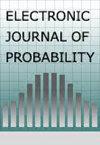具有无界标记的多体系统自由能的微观-宏观变分公式
IF 1.1
3区 数学
Q2 STATISTICS & PROBABILITY
引用次数: 0
摘要
相互作用的量子玻色气体是许多不同长度的布朗桥(循环)的随机集合,其中任意一对循环腿之间存在相互作用。它是一种标准的数学模型,用来证明著名的玻色-爱因斯坦凝聚相变。对自由能的定性理解是有帮助的,但目前还远远达不到。在本文中,我们展示了一种途径,以获得这种理解的模型的简化版本与确定性框而不是布朗循环。该模型是一个带有无界标记的泊松点过程,其中包含粒子和粒子之间的有界相互作用。尽管它不是一个量子模型,但它在精神上与量子模型很接近。对于任意粒子密度值的正则系综的极限自由能,我们导出了一个明确的、可解释的热力学极限变分公式。这个公式包含了模型的所有相关物理量,如微观和宏观的粒子密度,以及它们的互能和自能以及它们的熵。证明方法包括对标记泊松点过程的两步中宏大偏差方法和对小标记和大标记的明确区分;由于宏观标记的出现,不可能应用著名的三级原理本文章由计算机程序翻译,如有差异,请以英文原文为准。
A micro-macro variational formula for the free energy of a many-body system with unbounded marks
The interacting quantum Bose gas is a random ensemble of many Brownian bridges (cycles) of various lengths with interactions between any pair of legs of the cycles. It is one of the standard mathematical models in which a proof for the famous Bose–Einstein condensation phase transition is sought for. A qualitative understanding of the free energy would be helpful, but this is currently far out of reach. In this paper, we demonstrate a path towards gaining such an understanding for a simplified version of the model with deterministic boxes instead of Brownian cycles. This model is a marked Poisson point process with unbounded marks containing particles and bounded-reach interactions between the particles. Even though it is not a quantum model, it is close to that in spirit. We derive an explicit and interpretable variational formula in the thermodynamic limit for the limiting free energy of the canonical ensemble for any value of the particle density. This formula features all relevant physical quantities of the model, like the microscopic and the macroscopic particle densities, together with their mutual and self-energies and their entropies. The proof method comprises a two-step meso-macro large-deviation approach for marked Poisson point processes and an explicit distinction into small and large marks; an application of well-known level-three principles á la Georgii/Zessin is not possible because of the appearance of macro marks. The characteristic variational formula enables us to prove a number of properties of the limiting free energy as a function of the particle density, like differentiability and explicit upper and lower bounds, and a qualitative picture below and above the critical threshold (if it is finite). This proves a modified saturation nature of the phase transition. However, we have not yet succeeded in proving the existence of this phase transition.
求助全文
通过发布文献求助,成功后即可免费获取论文全文。
去求助
来源期刊

Electronic Journal of Probability
数学-统计学与概率论
CiteScore
1.80
自引率
7.10%
发文量
119
审稿时长
4-8 weeks
期刊介绍:
The Electronic Journal of Probability publishes full-size research articles in probability theory. The Electronic Communications in Probability (ECP), a sister journal of EJP, publishes short notes and research announcements in probability theory.
Both ECP and EJP are official journals of the Institute of Mathematical Statistics
and the Bernoulli society.
 求助内容:
求助内容: 应助结果提醒方式:
应助结果提醒方式:


